Red Golden Retriever: Everything You Need to Know About This Beautiful Breed
Pet love is a very sweet and pure feeling. Pets are our best friends who love us a lot. They make us happy when we are sad. They play and stay with us like family. When you care for your pets it teaches kindness. Their love makes our lives joyful.
Thinking about getting a Red Golden Retriever? They’re such sweet, gentle dogs who just want to be near you. Give them love and a little care, and they’ll become your best buddy and the soul of your home.
In this article, You can explore about this loving dog, including feeding, grooming, and providing them with plenty of exercise to keep them healthy and happy.
What is a Red Golden Retriever?
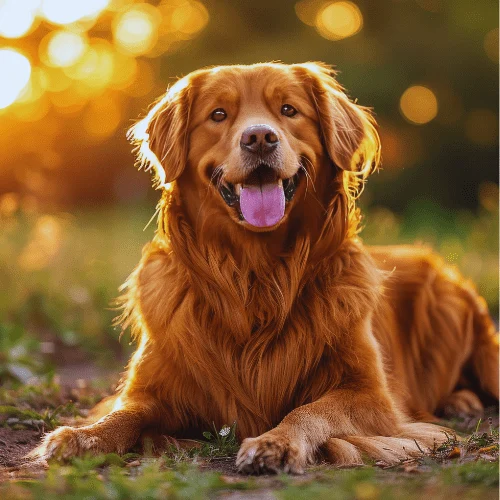
He is a beautiful version of the popular Golden Retriever breed. The Red Golden Retriever’s coat color is determined by specific genes that influence the depth and evenness of the color. The C gene gives them a rich tan, golden, or red coat, while the cch gene lightens the color. In Red Golden Retrievers, their C/C genes result in a bold, vibrant coat.
While most Golden Retrievers have light golden, cream, or white fur, the Red Golden Retriever has a striking deep red or mahogany coat. These dogs are also known for being smart, loyal, and loving, making them great companions for active families.
History

Origins in Scotland
The Red Golden Retriever traces its roots back to the late 19th century in Scotland, where Lord Tweedmouth, a British aristocrat, aimed to breed the perfect gun dog. His goal was to create a dog that was loyal, hardworking, and capable of retrieving shot game both on land and in water, making it an ideal companion for hunting. Lord Tweedmouth began by crossing a wavy coated yellow Retriever, named Nous, with a Tweed Water Spaniel, named Belle.
The First Puppies
This produced three yellow-colored puppies: Primrose, Crocus, and Cowslip. Over time, the breed continued to develop, incorporating other dogs like the Irish Setter, which introduced the red-colored coat we now associate with the Red Golden Retriever.
Soft Mouth Trait and Hunting Ability
The breed became particularly prized for its ability to retrieve without damaging the game, especially waterfowl like ducks, thanks to their soft-mouth trait. The Red Golden Retriever’s lineage, with contributions from the Bloodhound and Irish Red Setter, was ideal for the harsh conditions of the Scottish Highlands.
Adaptations for the Scottish Highlands
Their long coats were perfect for the cold climate, while their finely tuned noses helped them track prey with remarkable accuracy. Recognition and Popularity
In 1908, the UK Kennel Club recognized the breed, and by 1925, the American Kennel Club followed suit, making them popular not only as show dogs but also as beloved family companions in both the US and Canada.
Historical Significance and Popularity
Red Golden Retrievers have fascinated dog lovers for years with their stunning appearance and wonderful nature. Their popularity keeps rising, not only as adored family companions but also as key players in search and rescue, therapy programs, and various dog sports events.
Formal Recognition of Red Golden Retrievers
The Red Golden Retriever isn’t classified as a separate breed from the standard Golden Retriever. Golden Retriever as a whole, including the red-coated variety, was first recognized by the American Kennel Club (AKC) in 1925. Since then, this breed has remained one of the most popular in the United States, often ranking in the top five favorite dog breeds.
Although Golden Retrievers became popular in Britain by the late 1800s, they weren’t officially recognized as a distinct breed by the Kennel Club of England until 1911. This is when the classification of different coat colors started to become more defined.
How do Red Golden Retrievers Compare to Traditional Goldens?
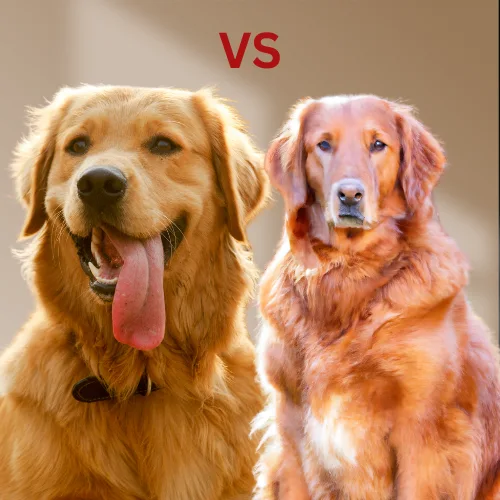
- Traits Between Red and Traditional Golden Retrievers
Red Golden Retrievers and Traditional Golden Retrievers share many similarities, but they also have a few key differences. Both types are intelligent, loyal, and friendly, making them wonderful family pets. - Coat Differences
Red Golden Retrievers have a distinct dark mahogany coat that comes from their Irish Setter ancestry, while Traditional Goldens have a lighter, golden coat. - Build and Physical Appearance
Red Golden Retrievers are usually a bit slimmer and more active than regular Golden Retrievers. Their fur is shorter and not as thick, so it’s a little easier to take care of. - Behavioral Similarities and Differences
Both types of Golden Retrievers are friendly, love kids, and always want to make you happy. But Red Goldens often have more energy. They’re a great match for active people or families who love going outside, playing, or taking long walks.
Appearance

The Red Retriever is famous for its good looks, with a thick coat that keeps water out and comes in shades of red. They are medium to large in size, strong, and well built. Their smart eyes and friendly nature make them special, and they stand out from other dogs.
| Weight | 55-75 pounds depending on the gender, with the male dog being larger. |
| Height | 21.5-24 inches depending on the gender, with the male dog being taller. |
| Build | Slender, lean, and muscular. The neck can sometimes be longer. |
| Coat Color | Between dark golden-fawn and mahogany. |
| Coat Length | Medium; however, Red Golden Retrievers can have slightly shorter fur. |
| Coat Type & Texture | Double coat with a wavy texture. |
Temperament
- Affectionate and Family Oriented
They are loving, devoted dogs, known for being affectionate and gentle. These traits make them excellent for families with children or other pets. With their empathetic and loyal personalities, they form strong bonds with family members. - Intelligent and Adaptable
Though they’re highly intelligent, they aren’t overly stubborn, and while not known to be particularly loud, they still have a strong urge to please their owners. This balance of traits makes them more adaptable and slightly easier to train than other dogs with stubbornness. - Energetic but Not Guard Dogs
Despite their energy and active nature, they’re not naturally inclined to be guard dogs. However, they are always on alert with a keen mind, ready to join in play. - Love for Games and Mental Stimulation
These dogs love games and benefit from mental challenges like puzzle toys or frozen Kong’s, helping keep their curious minds busy. - Importance of Physical Activity
They tend to get tired quickly if they don’t have enough physical activity, so regular walks or doggy playdates are important. - Gentle Mouth and Retrieving Instinct
Red Goldens also have a gentle, soft mouth when retrieving, an instinct from their history of being bred to bring back birds. Their naturally strong desire to carry things in their mouths doesn’t mean they are aggressive with their bite; in fact, they often use a gentle nudge or chew instead of causing any harm.
Red Golden Retriever Training
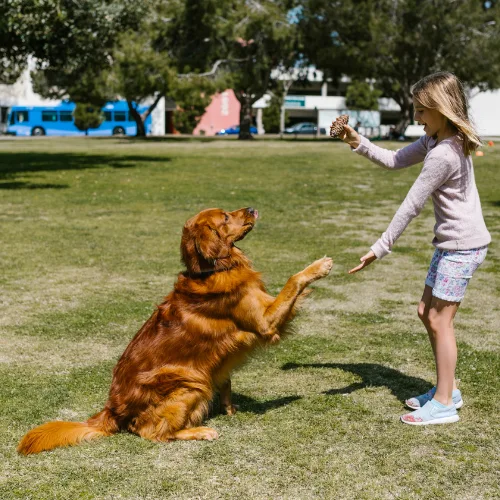
- High Trainability and Love for Learning
Their high trainability comes from their ability to quickly understand commands and their innate ability to grasp new tricks. They love treats, and training them becomes easier when you mix these rewards with tasks that mentally stimulate them. Using positive reinforcement is key, as they are naturally sensitive and want to do a good job. - Challenges in Training
While many of their traits make them easy to train, some things can make it challenging. For example, their love for everything and everyone can make it hard to keep their attention in public settings. - Importance of Fun and Engagement
If training isn’t fun, they might get distracted and look for something else to entertain them. The best way to keep their focus is to use consistent commands and include interactive activities that engage their minds, such as obedience training, agility competitions, or even therapy work. - Making the Most of Their Intellect and Work Ethic
To get the best out of their keen intellect and strong work ethic, it’s important to provide training that is not only engaging but also rewarding. - Effective Positive Reinforcement
They respond well to positive reinforcement techniques, making training both enjoyable and effective. Whether you’re working on basic commands or more complex tasks, Red Golden Retrievers will excel with the right approach, making them perfect for families or even working roles.
Positive Reinforcement Training Methods
To get the best out of their keen intellect and strong work ethic, it’s important to provide training that is not only engaging but also rewarding. They respond well to positive reinforcement techniques, making training both enjoyable and effective. Whether you’re working on basic commands or more complex tasks, they will excel with the right approach.
Diet and Nutrition
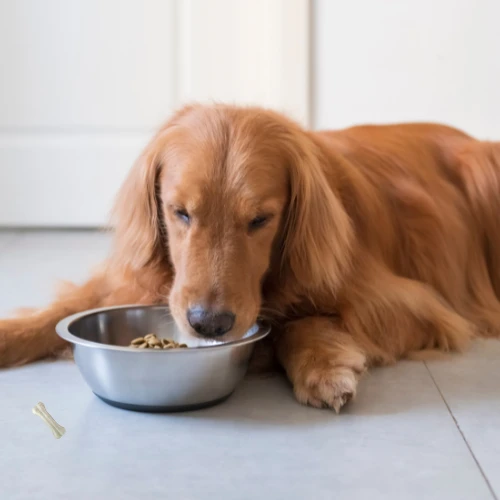
- Nutritional Focus for Red Golden Retrievers
A Red Golden Retriever’s diet should focus on providing high quality dog food with the right nutritional requirements to support their active lifestyle and maintain a healthy coat. Whether you choose wet food or dry food, make sure the protein content is high enough, as these dogs need plenty of proteins and essential fatty acids for their rapid growth and overall well-being. - Avoiding Overfeeding and Obesity
It’s important to avoid overfeeding, as they can be prone to obesity, which may worsen health issues like elbow dysplasia. To prevent this, offer treats in moderation and consult with your veterinarian for an appropriate feeding regimen based on their age, size, and activity level. - Feeding Large Breed Puppies Properly
When feeding large breed puppies, it’s essential to provide a balanced mix of minerals, vitamins, and nutrients to ensure proper growth and avoid issues like knuckling, where the joints may buckle due to uneven growth. - Choosing the Right Food Type
Red Golden Retrievers can eat dry, canned, or a combination of both types of food, but the ingredients are what really count. Focus on a balance of animal-based protein, fat, and minimal grain or artificial additives. - Portion Control and Monitoring
Feed them 2 to 3 cups per day, depending on their size, age, and activity level. Keeping their diet balanced and monitoring their body condition regularly can help them thrive.
Common Red Golden Retriever Health Issues
Red Golden Retrievers, like many large breeds, can face several health challenges. Being aware of warning signs and preventive measures .You can help your dog stays healthy and happy. According to the American Kennel Club (AKC) here’s an overview of common health issues, along with what to look out for and how to prevent them.
Hip and elbow dysplasia
These joint problems can cause pain, stiffness, and difficulty walking. Warning signs include limping, trouble standing up, or avoiding stairs. Preventive measures include maintaining a healthy weight, avoiding high-impact exercises while they’re young, and providing joint supplements recommended by a vet.
Hypothyroidism
This thyroid condition leads to symptoms like weight gain, low energy, and dry skin. Warning signs are unexplained weight gain, tiredness, and a dull coat. Prevention involves regular vet check-ups, which can help detect early thyroid problems. Medication can manage this condition effectively.
Subaortic stenosis (SAS)
This heart condition can cause shortness of breath, fatigue, or even fainting in severe cases. Regular heart check-ups can help catch this condition early. Avoid over-exerting your dog if they have this issue and follow your vet’s advice on managing activity levels.
Eye disorders
Cataracts, progressive retinal atrophy, and glaucoma are some eye issues that can lead to vision loss. Warning signs include cloudy eyes, bumping into things, or squinting. Regular eye exams and keeping your dog’s eyes clean can help detect problems early.
Mast cell tumors, lymphoma, osteosarcoma, and hemangiosarcoma
These cancers are more common in Red Golden Retrievers. Mast cell tumors appear as lumps on the skin. Lymphoma causes swollen lymph nodes, osteosarcoma affects the bones causing pain and limping, and hemangiosarcoma affects blood vessels, often impacting organs like the spleen or liver. Warning signs include lumps, swelling, weight loss, or unusual bleeding.
Seizures:
Epilepsy can cause sudden convulsions or strange behaviors like staring or twitching. If you notice your dog having seizures, consult your vet immediately. Medications can often manage epilepsy well, allowing your dog to live comfortably.
Skin problems (like hot spots)
These irritated, painful patches are often caused by excessive licking, scratching, or allergies. Warning signs include redness, hair loss, or oozing skin. Prevention includes regular grooming, keeping your dog’s skin clean and addressing allergies early with vet recommended treatment.
Preventive Measures for Overall Health
1. Regular Vet Check-Ups
Early detection of health problems can make a big difference.
2. Balanced Diet
Feed them high-quality food with adequate protein and nutrients to support their overall health and prevent obesity.
3. Healthy Weight
Avoid overfeeding and keep them active to reduce the risk of joint problems and heart conditions.
4. Exercise
Provide regular, moderate exercise to keep their muscles strong without putting too much strain on their joints.
5. Grooming
Regular grooming can help you spot lumps, skin issues, or eye problems early.
By being mindful of these warning signs and preventive measures, you can help ensure your Red Golden Retriever stays healthy and enjoys a long, active life.
Regular Veterinary Check-ups and Preventive Care
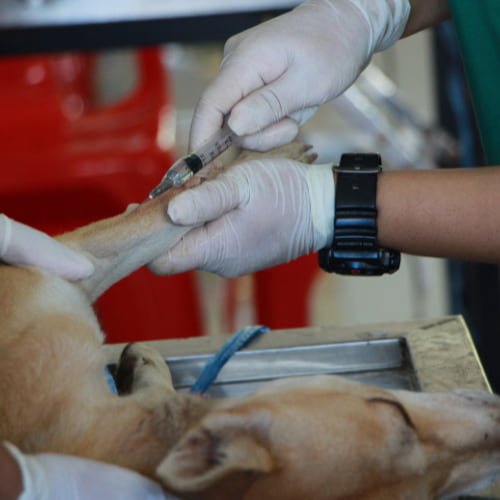
Regular veterinary check-ups and preventive care are essential for maintaining the overall health and well-being of Red Golden Retrievers. Routine vaccinations, parasite control, dental care, and nutrition management are key components of a comprehensive healthcare regimen.
Early detection and intervention can help prevent or manage potential health issues, ensuring a long and healthy life for these beloved companions.
Grooming Requirements
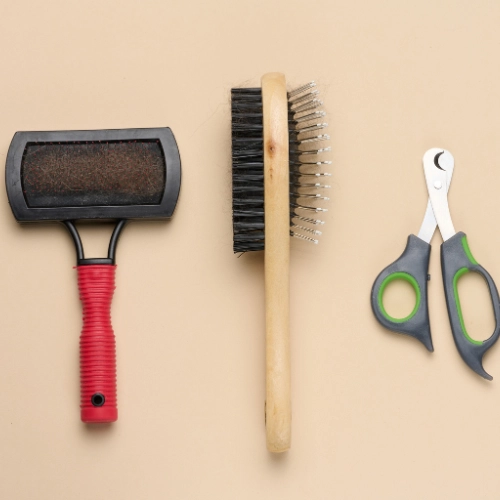
1. Regular Grooming for a Dense Coat
Caring for a Red Golden Retriever involves regular grooming to keep their dense, water repellent coat in optimal condition. Their thick double coat needs constant brushing, especially during shedding seasons, to prevent matting and remove loose fur.
2. Daily Brushing
Use a high quality grooming brush and brush every day, ideally in the morning, making sure to reach the shaggy hair around the ears.
3. Occasional Haircuts
Along with brushing, an occasional haircut for the fur around the ears, tail, feet, and neck helps prevent matting and keeps them looking smart. Some owners prefer professional groomers, but if your dog is calm, you can do it yourself.
4. Bathing to Maintain Coat Health
Bathing is another essential part of grooming. Red Retrievers need a bath to keep their hair sleek and manageable, but don’t overdo it since their coats contain natural oil.
Using the right canine care products will nourish their medium-long-haired coat, and dog-formulated shampoos can help protect them against fleas and insect bites.
5.Dental Care
Regular care of their teeth is crucial. Chewing with doggie chew toys or bare bones helps keep their teeth healthy and prevents plaque buildup.
6.Nail Care
Nail trimming should be done once a month to prevent overgrowth, which can cause discomfort or difficulty .
7.Ear Care
Clean their floppy ears weekly to prevent infections caused by dirt, moisture, or debris from playing in the grass and earth.
Exercise and Activity
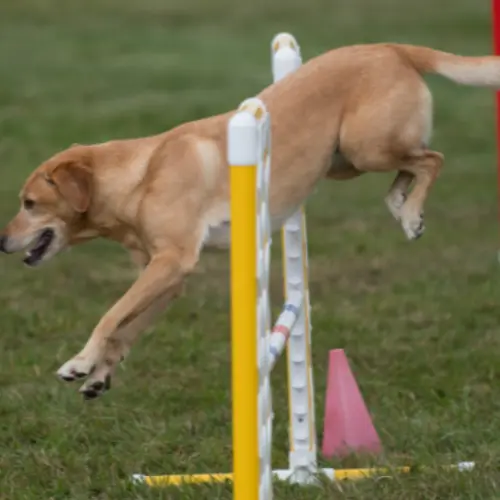
Exercise Needs for a Red Golden Retriever
A Red Golden Retriever needs a moderate energy level, so their exercise routine isn’t overly demanding but still necessary to stay healthy. You should plan for at least half hour to hour long walks in the morning or afternoon to help them stretch their legs. Fetch is an ideal game to play since these dogs have a natural instinct to retrieve, and it’s an excellent way to burn off some energy.
Consequences of Inadequate Exercise
If they don’t get enough physical activity, they may become destructive and start chewing on things like shoes or furniture. However, when they get their proper exercise, they are calm and relaxed, often curling up by your feet while you watch TV.
Intelligence and Purposeful Activities
These dogs are highly intelligent, bred for hunting and sport. They love to have a purpose and enjoy activities like running, swimming, and long hikes. Your Red Golden Retriever will benefit from interactive games like obedience or agility, helping them use their mind as well as their body.
Living Space and Energy Channeling
They are best suited for homes with large living spaces and outdoor access, but with a bit of extra activity like training sessions and puzzle toys, they can easily adjust to smaller spaces, provided their energy is channeled into something productive.
Daily exercise requirement:
At least one hour a day of physical activity.
Exercise variety:
Physical: Running, fetching, and swimming
Mental stimulation:
Puzzle toys and scent games
Exercise Suggestions:
Long walks or hikes
Playing fetch or frisbee
Agility or obedience training
Interactive playtime with toys.
Energy and Space
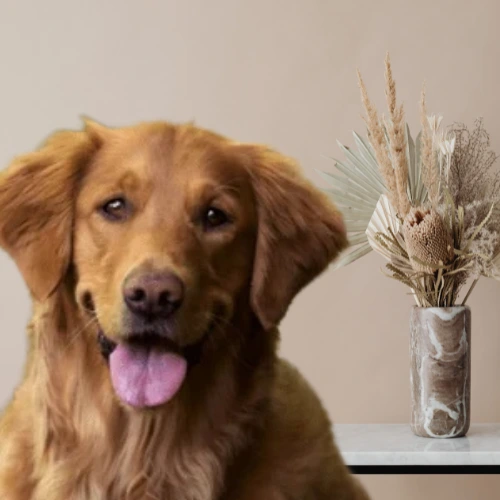
They are energetic dogs and require daily exercise to stay physically and mentally stimulated. They’re best suited for homes with a backyard or access to open spaces for play and exercise.
Work
They were originally bred to work as hunting dogs, Red Retrievers are extremely easy to r a variety of other roles such as: train and can also be used for
- Search and rescue dogs
- Therapy dogs
- Most service dog jobs – Including but not limited to guide dogs, hearing dogs, epilepsy dogs, and diabetes dogs.
- Tracking dogs
- Contraband detection dogs
Each of these rolls utilizes some area of the Red Golden Retriever’s natural ability, be it their highly sensitive sense of smell, soft mouths, responsiveness to training, or gentle, empathetic temperaments. They are particularly favored as service dogs because they are so personable and often form fantastic bonds with their handlers.
Lifestyle
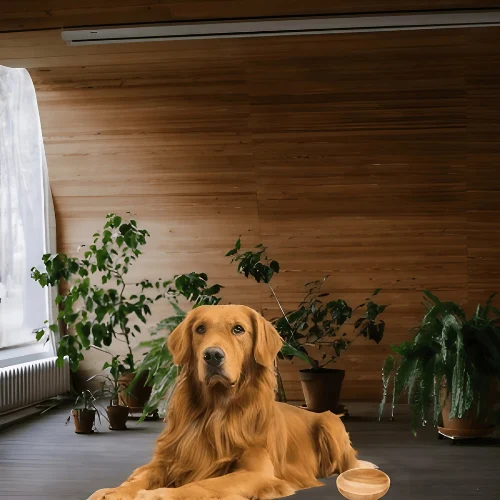
This breed is friendly but not quite as sociable as the Golden color Retriever. It’s confident, although can get easily spooked with sudden noises or objects coming quickly towards it. That will cause them to bark. They are not known to bark a lot unless they are bored, spooked or in distress.
They can be stubborn and sulk if they get bored or are asked to do something they really don’t want to do. As a puppy they will bite and chew things if left alone so it is best to keep a supply of chew toys around.
Pros and cons of retriever
| Pros | Cons |
| Unwavering Loyalty: Highly loyal and affectionate, making them great family companions. | High Energy Needs: Require regular exercise and mental stimulation to avoid boredom and undesirable behaviors. |
| Gentle and Calm Temperament: Ideal for households with children and other pets due to their loving and patient nature. | Grooming Demands: Their thick double coat requires frequent brushing to prevent matting and maintain health. |
| Versatile and Intelligent: Can serve as loving pets, therapy animals, and service dogs. Slightly more intelligent than standard Golden Retrievers. | Health Risks: Prone to conditions like hip dysplasia and certain cancers, requiring regular vet check-ups. |
| Stunning Appearance: Majestic red coat and graceful, elegant look make them visually striking. | Not a Guard Dog: Not suited for guarding, and may bark when left alone or seeking attention. |
| Energetic and Active: Enjoy activities like swimming and running, making them fun and engaging playmates. | Destructive Behavior: Can chew, bite, or chase small animals when bored or left unattended. |
| Companionship-Oriented: Will follow you around, offering constant companionship and affection. | Need for Activity: Thrive in active environments and can become restless in sedentary lifestyles. |
| Shedding Issues: Regular shedding requires consistent grooming to manage their coat. | |
| Stubbornness: Can be obstinate, trying to take over spaces like sofas or beds if not properly managed. |
Red Golden Retriever Lifespan
The average lifespan of a Red Golden Retriever is about 10 to 12 years. Some live longer, while others may not live as long. Regular vet care can help your dog stay healthy and live longer.
This includes routine check-ups, vaccinations, and dental care to prevent gum disease. Your vet can also suggest a care plan that’s best for your dog’s specific needs.
Conclusion
Before welcoming a Red Golden Retriever into your home . You must assess your lifestyle and living conditions. Do you have such capacity to meet the breed’s needs?
If you’re ready to offer the care, attention, and affection they require from you. You’ll gain a devoted companion who will bring happiness and enrichment to your life for many years.
FAQs
Are red Golden Retrievers smart?
Yes, red Golden Retrievers are highly intelligent, just like their standard-colored counterparts. They are quick learners and excel in obedience, making them easy to train for tasks and commands.
Are red Goldens more hyper?
Red Golden Retrievers are not inherently more hyper than other Golden Retrievers. However, their energy levels may vary individually, depending on genetics and lifestyle, just like in any other dog of the breed.
What is the difference between a red and gold Golden Retriever?
The primary difference between red and gold Golden Retrievers lies in their coat color. Red Golden Retrievers have a deeper, reddish hue compared to the standard golden coat. Additionally, reds tend to have a slightly leaner build and a shorter, more streamlined coat.
